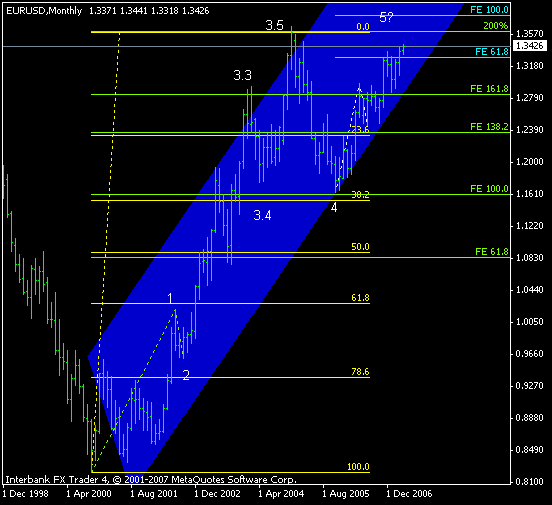Thank you for a good information on Elliott Waves.
Elliott Wave Theory 7 replies
The Fundamental Error of Elliott Wave Theory 36 replies
A more modern Elliott wave theory book? 2 replies
elliott wave theory 1 reply
Wave Theory 1 reply
a) Markets unfold in patterns
b) Where prices are within that pattern
c) What to expect next
d) Exactly what can and cannot happen for your expectation to remain valid, and,
e) Social mood, not headlines, is what moves markets
DislikedIf the Dow is in a corrective wave up from a down impulse (?), it is doing a damn good job of disguising itself.
I would expect thursday to have some kind of a pullback after such a big move today as well as the fact that it has retraced 61.8% of the down move from the high one month ago.
But will have to see whether or not the party is over.
BTW I have a sister who does sell real estate in Manhattan with one of the biggest firms. I sent her the letter EWI got and her opinion is that although the market is priced ridiculously (has been for a long time though) and has slowed dramatically, the writer doesn't sound like someone in the biz to her. Whatever.
Also I can't help but notice that each of those EWI newsletters have ordering information. Ca-ching. I guess it is a fixation of mine.
Keep 'em coming.Ignored
All Man FX Clear LLC foreign exchange facilities are enhanced by our systems and infrastructure resources, which include Web-based access to live pricing, reporting and margin monitoring.
This is what is written on the "Education" page of their website:
FUTURES AND OPTIONS EDUCATION
We offer professional derivatives training programs that are predicated on financial theory; yet our emphasis is on the application and strategy of how to implement derivatives to manage risk through portfolio modification. Participants in our derivatives programs have come to us from more than 60 countries, and represent a variety of the world’s largest institutions, including more than a dozen central banks, supra-national organizations, securities companies, commercial banks, hedge-funds, corporations, insurance companies, government agencies and financial exchanges. Three Day Option Workshop
Five Day Futures and Options Seminar
Three Week Futures and Options Seminar
Customized programs are available upon request
Commodities
Commodities Central is where you’ll learn more about the physical commodities markets and their unique fundamentals. From silver to soybeans, find out what drives these markets and how they are traded. You’ll also find links to North American exchanges offering trading in physical commodities and a list of contracts available to trade. NFA Educational Materials
The following materials have been provided by the National Futures Association (NFA) to help you make informed financial decisions. These publications are the property of National Futures Association. Buying Options on Futures Contracts: A Guide to Uses and Risks (27 pages)
A Guide to Understanding Opportunities and Risks in Futures Trading (50 pages)
Volatility Futures
Volatility futures provide investors the ability to act on their opinion of stock market volatility direction and magnitude. Stock market volatility became a tradable part of the investment landscape in March 2004, with the introduction of futures on the CBOE Volatility Index![]() , or VIX
, or VIX![]() , at the CBOE Futures Exchange. The CBOE developed the VIX in 1993, and it measures market expectations of near-term volatility conveyed by stock index option prices.
, at the CBOE Futures Exchange. The CBOE developed the VIX in 1993, and it measures market expectations of near-term volatility conveyed by stock index option prices.
Additional Material
What You Should Know Before You Trade from the CFTC
Economic Purposes of Commodity Futures Trading, from the CFTC
The CFTC Glossary: A Guide to the Language of the Futures Industry, from the CFTC
Introduction to the Futures and Options Markets, from the Institute for Financial Markets
The CBOT Mini-Sized Dow: Trading the Market's Measure, from the CBOT
Elliott Wave International
http://www.refco.com/images/divider.gif
http://www.refco.com/images/elliotWave.gif Refco invites you to receive a free 14-day trial of Elliott Wave International's premium market analysis featuring 24-hour intraday, daily and long-term coverage of all major markets worldwide... http://www.refco.com/images/more.gif
http://www.refco.com/resources/rs.education.asp
http://www.elliottwave.com/images/ez.../Soybeans2.GIF
So, there you have it, three clear reasons why the Soybeans market behaved so erratically in March. Instead of guessing about crop hauls, Jeffrey believes the market jumped around because it is in a corrective phase, and corrections are much harder to predict than impulse waves.
The question is just how far will Soybeans slide before wave 2 ends and wave 3 begins.

DislikedDo you know how to tell a regular flat correction from an expanded one? While similar at first glance, they have different implications for the correction's ending price target. Watch this free clip from last Friday's (Mar. 23) Daily Futures Junctures Weekly Wrap-Up video where editor Jeffrey Kennedy analyzes an expanded flat correction in Pork Bellies.
Every Friday in his Weekly Wrap-Up, EWI's Chief Commodities Analyst Jeffrey Kennedy tells you about the hottest trends in commodity markets.
Watch this free clip from last Friday's (March 23) Daily Futures Junctures Weekly Wrap-Up, where Jeffrey analyzes Elliott wave patterns in Pork Bellies.
http://www.elliottwave.com/features/...ideo=3_26_2007Ignored
